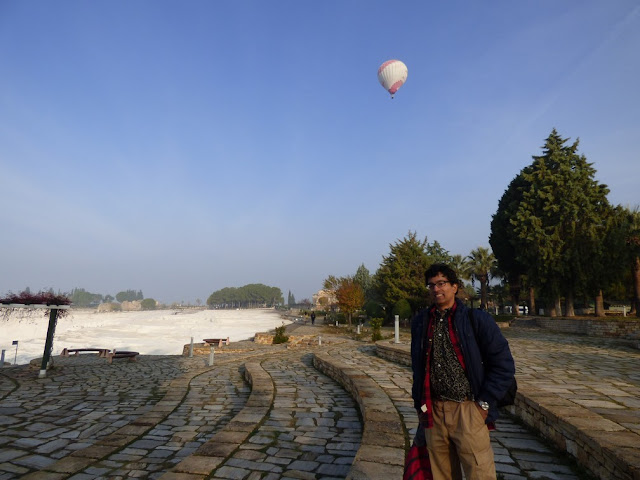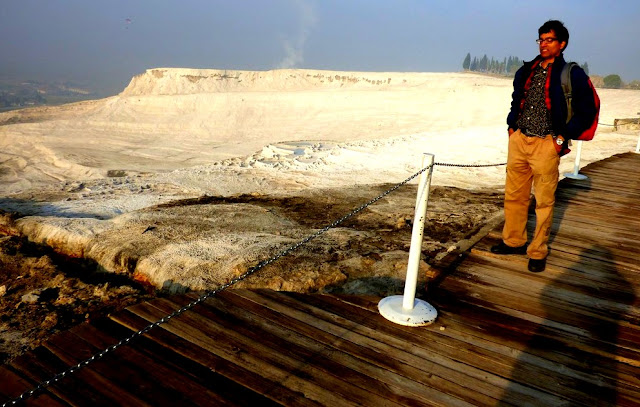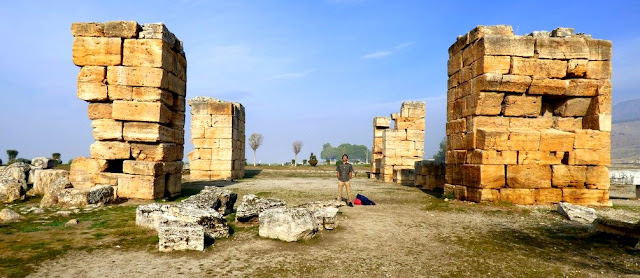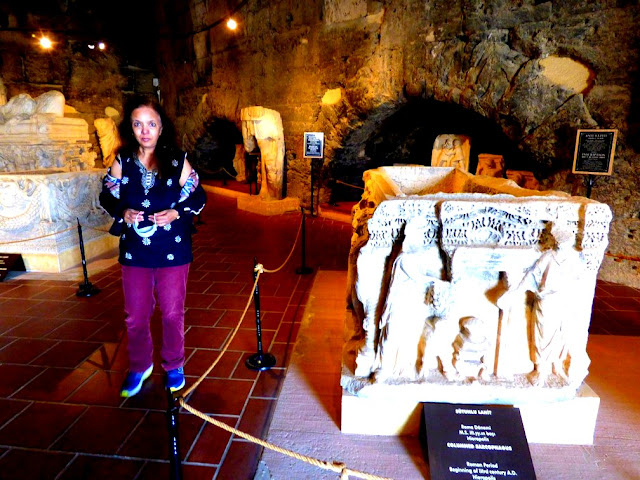NOV 26, 2021, FRIDAY:
SUMMARY: Pamukkale travertine terraces and Hieropolis , both fantastic.
PAMUKKALE
Pamukkale is actually a two-in-one deal for attractions, with the ruins of the Roman spa town of Hierapolis sitting on the travertine mountain's summit. Here, as well as the preserved ruins of a theater and other grand monuments, there is the renowned hot spring pool, where the Romans bathed away aches and pains.
This is our hotel... we parked our car inside as can be seen. The hotel has its own supply of the special spa water piped in. It comes in piping hot and we had to fill it in a bucket and mix cold water for a bath. Their tub was massive, so we did not have time for filling it up. The water has a medicinal aroma and it was quite the experience.
We drove to the Travertine terraces. There were hot air balloons...
STRAY DOGS
Travertines
The dazzling white calcite cliff of Pamukkale was created by calcium deposits from the area's hot springs. In the same way that stalactites form within limestone caves, the deposits grow on the steep slopes, gradually fanning out to form natural terraces. Pamukkale means "cotton castle," and the blinding white color of these travertines do look like a bizarre natural fortress of sorts.
The best way to do sightseeing here is to walk from the base of the calcite mountain up the entire cliff ridge. The terraces at the upper levels hold pools of water, which you can sit in.
There are boardwalks and observation platforms with benches.
Took off the shoes and waded in here... the spring water was cold, just lukewarm in one place.
They had these wings for taking pictures against the salt flats...
Pamukkale Castle
Pamukkale (Cotton Castle) was originally only the name of this 11th- or 12th-century castle, which sits just off the road leading from Pamukkale town up to the Hierapolis plateau. Most tourists don't bother coming up here, so this is a great chance to get away from the tour bus crowds for a while.
there are superb views over the travertines from the castle ruins, which are well worth the detour. Sunset is the best time to come, as the changing light makes the travertine terraces glow.
Some more travertine...The spring forms blue pools here before entering the terrace area...
Could see the steam as the weather was pretty cold... the water was just lukewarm...
Hierapolis City Ruins
First founded by King Eumenes II of Pergamon soon after 190 BC, Hierapolis was originally a fortified military colony. The original city was destroyed by an earthquake in AD 60, and it was after the rebuilding that its glory days began.
The city enjoyed its greatest prosperity during the 2nd and 3rd century when, with its on-tap natural hot springs, it became an important spa center. The remains of a grand colonnaded street run parallel to the travertines below for just over one kilometer, extending between the necropolis to the north and a Byzantine church at the southern end.
From the church, if you take the eastern path, you come to the Temple of Apollo and its famed Plutonium (a cave beneath the temple that was a source of poisonous gas). Here, the priests would consult the oracle, bringing in birds and small animals killed by the rising gas.
Today, nothing much survives of either. East from the remnants of the Agora is the octagonal Martyrium of the Apostle Philip, built on the spot where the saint and his children were supposedly martyred after he remonstrated with the pagan-worshippers of Hierapolis.
MUSEUM
This small but excellent museum dedicated to Hierapolis is inside the ancient city's former Roman bath house. A visit here will help bring the city to life. The exhibits showcase some of the beautiful artistry and cultural heritage of this once important city, displaying a variety of finds from the site, including gorgeous and intricate stone reliefs, sarcophagi, and statuary.
The museum also has a decent collection of statuary from the nearby archaeological site of Aphrodisias.
We went uphill toward the theater...
Hierapolis Theater
On a slope above the rest of the Hierapolis ruins is the mighty theater, with its facade over 100 meters long and two tiers of seating, each with 26 rows.
Built during the reigns of the Roman Emperors Hadrian and Septimius Severus, the theater is incredibly well-preserved. It has retained much of its original detail, with the imperial boxes (where VIP guests would have watched the entertainment) and some decorative panels along the stage still surviving. There are fine views from the top seating tiers.
Pamukkale Antique Pool
to partake in some restorative hot-pool soaking just like the Romans did–but without the togas look no further. Pamukkale's Antique Pool (beside the Temple of Apollo)has mineral-rich hot spring water that is a steady 36 degrees Celsius.
It's possibly the most atmospheric hot spring experience , with half-submerged columns and chunks of fallen marble scattered in the water all around .
We retraced our way back to the car park
Drove back toward the hotel.
Report continues here
https://adventuretrav.blogspot.com/2022/01/turkey-trip-report-days-17-18.html










































































































No comments:
Post a Comment